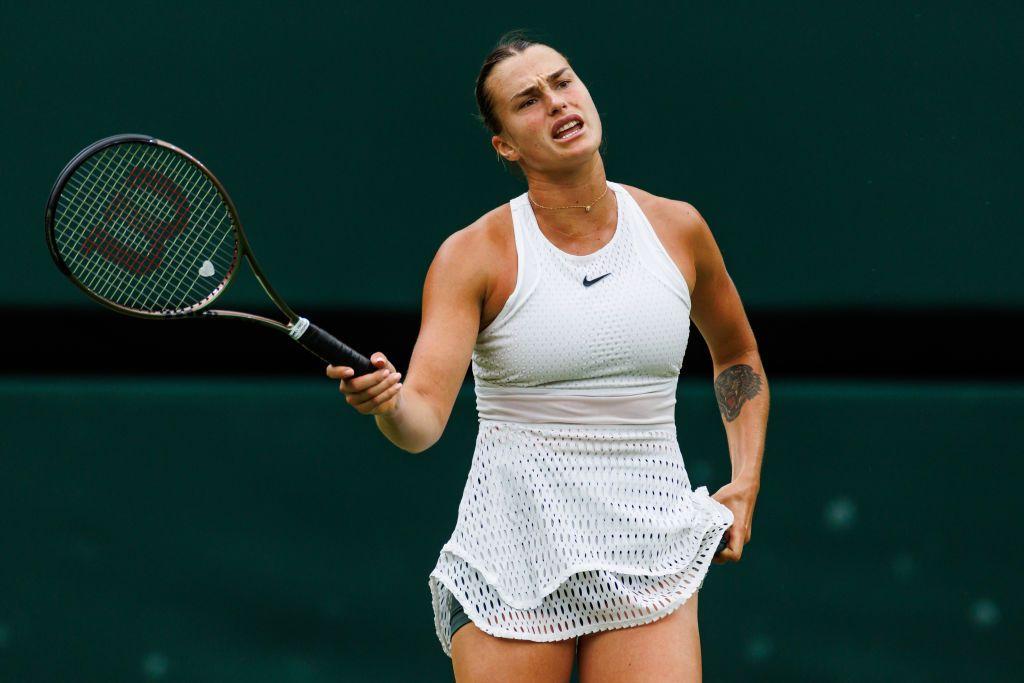BBC Sport has been asking for your questions during Wimbledon 2025.
Hundreds of you have been in touch and we’ve picked out some of the best to take a look at.
Read on for insight from our Ask Me Anything team into scheduling secrets, glamorous guests, and bathroom breaks…
Why does Novak Djokovic always play on Centre Court?
Michael in York
Seven-time Wimbledon winner Djokovic may only be the sixth seed at this year’s tournament, but his status as a legend of the sport means big crowds are still very keen to watch him – more so than some of his higher-ranked rivals.
That means that, more often than not, he is given highest billing.
The All England Lawn Tennis Club (AELTC), which operates the Championships, told the BBC: “The scheduling of the order of play each day is a complex operation. We take great care when scheduling matches and allocating courts. All decisions are made with fairness and the best interests of the tournament, players, spectators and our worldwide broadcast audience at heart.
“Novak is a 24-time Grand Slam singles champion so that is certainly a factor when scheduling.”
The last time Djokovic played anywhere other than Centre Court at Wimbledon was in 2021, when he beat American player Denis Kudla in straight sets on Court One.
He last played away from the two show courts in 2018, when he beat Horacio Zeballos in straights sets on Court Two.

Are tennis umpires allowed toilet breaks?
Natalie in Surbiton
Yes, although they do their best to avoid it.
An umpire’s job is to manage a tennis match as efficiently as possible, without impacting play. Therefore, taking a toilet break and delaying play is far from ideal.
Umpires often restrict how much they eat and drink before matches in order to avoid having to take a bathroom break.
In fact, when Swedish umpire Mohamed Lahyani officiated the longest match in Wimbledon history between John Isner and Nicolas Mahut in 2010, he did not take a bathroom break at any point.
But sometimes, nature calls – in which case an umpire will aim to keep the delay as short as possible.
What is the longest ever single game at Wimbledon?
Andy in Northampton
Isner and Mahut may have produced the longest ever match in Wimbledon history, but they didn’t play the longest individual game.
The longest game played in the singles at Wimbledon was between Spaniard Tommy Robredo and Italy’s Potito Starace in the first round in 2004. Though 20th seed Robredo won in straight sets, their match included a game which reached a whopping 34 points.
The second longest game was the 32-point epic produced during the 2023 final between Carlos Alcaraz and Novak Djokovic. That lasted 26 minutes.
Djokovic had eight game points on serve, but was unable to convert any of them, and Alcaraz managed to take advantage of his seventh break point on his way to victory.
What is the fastest ever serve at Wimbledon?
Amy in Cambridgeshire
The fastest serve ever recorded at Wimbledon was hit this year by Frenchman Giovanni Mpetshi Perricard during his first-round defeat by Taylor Fritz.
The 6ft 8in 21-year-old smacked down a 153mph serve, though Fritz won the point.
The fastest serve ever recorded was 163.7mph – by Australian Sam Groth at the 2012 Busan Open Challenger.
That event is not recognised by the elite ATP Tour. The fastest ever serve at one of its competitions came from Isner during a 2016 Davis Cup tie against Australia.
The fastest ever women’s serve was 136.7mph – by Spanish player Georgina Garcia Perez at the 2018 Hungarian Ladies Open, though the fastest on the elite WTA Tour was from Sabine Lisicki of Germany, who hit a 131mph effort at Stanford in 2014.
At Wimbledon, the fastest women’s serve is the 129mph Venus Williams achieved in 2008.
The point at which serve speed is measured is just after it leaves the racket.

Why do post-match interviewers stand so far away from players?
Duncan in Northampton
When athletes finish a match in some sports, they are interviewed by a reporter who stands in close proximity to them.
Not so at Wimbledon, where post-match interviews are conducted from a few feet away. The reason? Quite simply, so there is a clear view of the players.
A clean shot of the players is better for broadcast, both live at the time and also for wider use on international news coverage and social media feeds in the aftermath.
How many tennis balls are used at Wimbledon each year?
Katie in Shrewsbury
New tennis balls are used after the first seven games of a match, then after every nine subsequent games. New balls are used so that old ones with reduced air pressure from play do not compromise the quality of matches.
The AELTC estimates about 55,000 balls are used per year.
Some old balls are subsequently sold to the public, with the money raised going to the Wimbledon Foundation. Others may be donated to the Lawn Tennis Association for distribution to tennis clubs.

How many times are players allowed to bounce the ball before serving?
Keith in Poole
There is no limit to how many times a player can bounce the ball before serving.
The majority of players have a consistent ball-bouncing ritual – the strength of the bounces and the number depends on each player.
The bouncing serves no practical purpose, but is designed to aid with concentration, giving the player a few seconds to focus on what kind of serve they are aiming to hit, to allow the crowd to quieten, and to create a rhythm between the ball and body while calming any nerves.
Two things can, however, restrict a player’s bouncing of the ball.
The first is the shot clock. From the end of the previous point, the server has 25 seconds to hit their first serve. Take longer and the umpire can call a violation. Violations can eventually lead to the concession of a point. Umpires are generally lenient with the shot-clock rule unless a player’s delays are especially egregious.
If a player is performing a particularly high number of bounces before serves, or feinting to serve before continuing to bounce further, they could draw the ire of an irritated opponent.
That happened when Chile’s Nicolas Jarry complained about British player Cameron Norrie at this year’s tournament.
What is the device tennis players clip on to their rackets?
Alisson in Glastonbury
Some players attach small silicone or rubber shock absorbers to the strings of their rackets which are known as dampeners.
There are two types of dampener – button (round) and worm (long but thin and woven through strings).
They are used to reduce the level of vibration felt through the racket each time the ball is struck, especially if contact is made off-centre.
The aim is to increase the player’s comfort and provide a more muted, softened feel when connecting with a shot.
Dampeners also alter the sound that is made when the ball is struck – lowering the high-pitch ping into a thud.
Not every player uses a dampener, though. Some prefer the more natural feel of bare strings.
For example, Roger Federer did not typically use a dampener during his career, whereas Rafael Nadal did.

What is the cut-off age for juniors at Wimbledon?
Marilyn in London
The boys’ and girls’ tournaments at Wimbledon feature players aged between 14 and 18 on 1 January each year.
Junior players receive no prize money, but are awarded points which count towards their international junior ranking.
Young players from around the world travel to participate.
Of course, players below the age of 18 can participate in the senior Wimbledon tournament if they are ranked highly enough, come through the qualifiers, or are given a wildcard.
Boris Becker was only 17 when he won the men’s singles in 1985.
Some players even participate in both the junior and senior categories – British 17-year-old Mimi Xu played in both this year, for example.
What is the difference between an unforced and forced error?
Allan in Aberdeen
Whether an error is ‘unforced’ or not involves an element of subjectivity, but is generally used to describe a shot missed by a player when they were in full control of their body and racket.
For example, if a player is standing in the middle of the baseline and crashes a basic forehand against the back wall, that would count as an unforced error as they missed because of their own error.
But if a player is under huge pressure from their opponent, and eventually misses a shot after being forced out wide and barely connecting with a powerfully struck shot, the error has been forced because their body movement and racket swing was heavily compromised by their rival’s play.
Unforced error totals are an interesting way to measure how well (or not) a player is doing on court.
Some players with a naturally more aggressive style may be more likely to rack up higher unforced error totals than those who employ a more defensive style.

What is Ask Me Anything?
Ask Me Anything is a service dedicated to answering your questions. Thanks, all!
We want to reward your time by telling you things you do not know and reminding you of things you do.
The team explores everything you need to know and calls upon a network of contacts including our experts and pundits.
We answer your questions from the heart of the BBC Sport newsroom, and go behind the scenes at some of the world’s biggest sporting events.
Our coverage spans the BBC Sport website, app, social media and YouTube accounts, plus BBC TV and radio.
More questions answered…
- How are Wimbledon wildcards decided?
- Could you qualify for Wimbledon?
- Why are there no line judges at Wimbledon?
- What are the heat rules at Wimbledon?
- Why do tennis players drink pickle juice?
O que achou dessa notícia? Deixe um comentário abaixo e/ou compartilhe em suas redes sociais. Assim conseguiremos tornar o tênis cada vez mais popular!
Esta notícia foi originalmente publicada em:
Fonte original
Autor:
